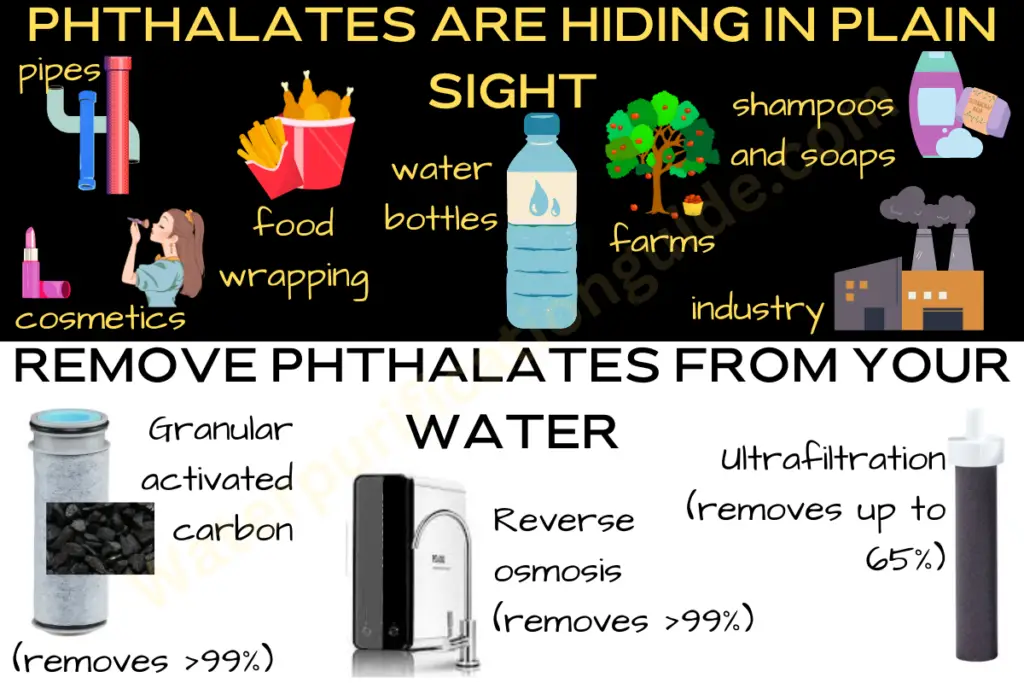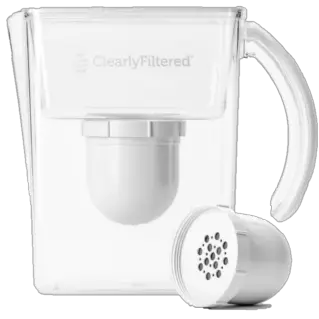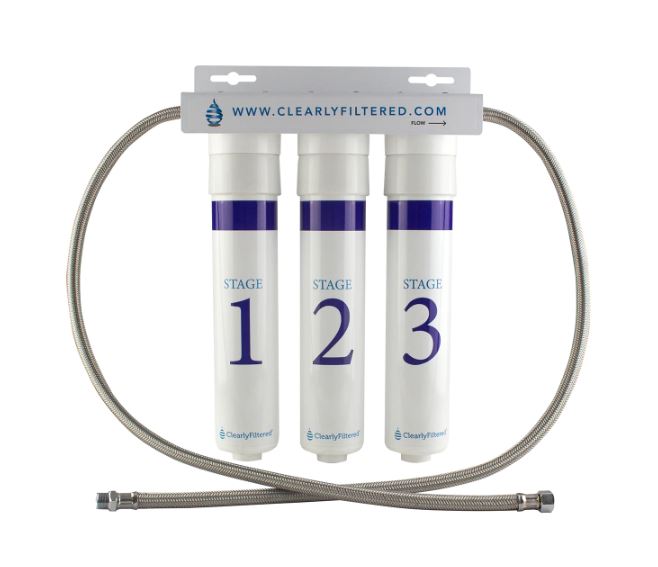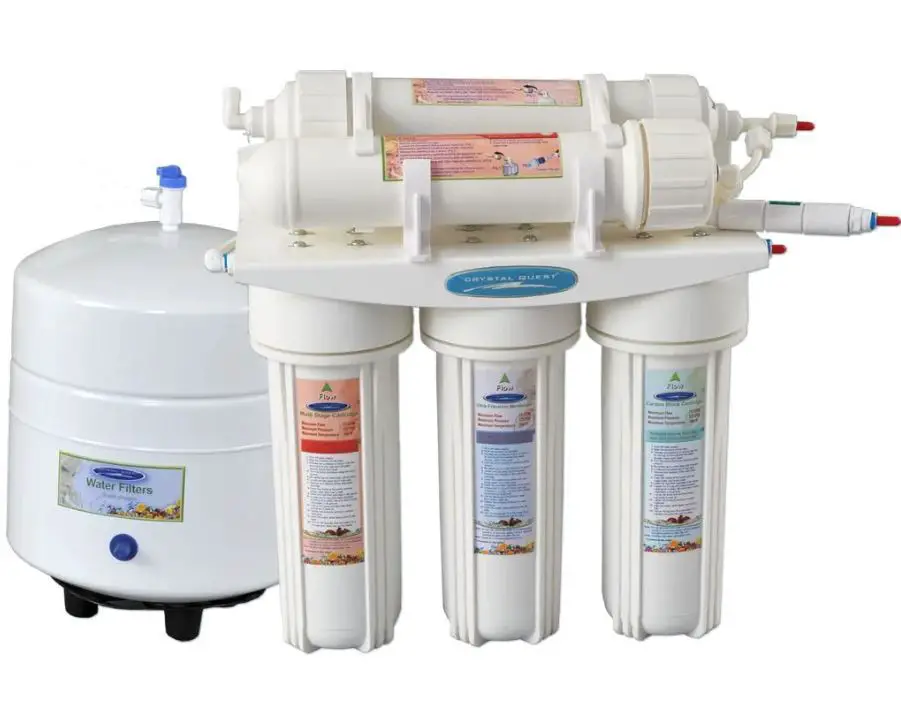The phthalates found in our water cannot be seen, tasted, or smelled. Reverse osmosis and granular activated carbon can effectively remove >99% of the phthalates in your water. While ultrafiltration is only somewhat effective (<65%). Phthalates enter our water supply from the degrading of plastic products, pesticides and cosmetics.
More than 460 million pounds of phthalates are produced each year, and that number is rising. Unfortunately, phthalates are everywhere in our environment, and especially in our water.
This article will provide you with information on what exactly phthalates are and why they are harmful to human health. But most importantly, we explain in detail how phthalates enter our water and how to remove them so you can drink pure, clean water.
- Reverse osmosis (RO) systems and granular activated carbon (GAC) filters are the most effective way to remove phthalates from water.
- Phthalates enter our water from leaching, spraying, washing, solar exposure on plastics and degradation of pipes.
- Some water filter pitchers, reverse omosis systems and under-sink filters can remove >99% of the phthalates in water.
5 Reasons Why We Are Drinking Phthalates With Our Water
Phthalates are a group of man-made chemicals used to make plastics last longer and to make them more flexible. They are also called plasticizers.
These plasticizers are colorless, odorless, syrupy liquids that we have no way of detecting when drinking our water.
Phthalates are found in hundreds of products, including:
- Detergents
- Insecticides
- Lubricants
- Shower curtains
- Cosmetics
- Personal care products, like perfumes, hairsprays, nail polish, and soap.
In fact items like boots, shower curtains and food packaging materials, made from flexible plastics can contain as much as 30% of phthalates by weight. But without phthalates, these everyday items would be hard and inflexible, and useless to us.
Phthalates cannot be seen, tasted, or smelt, but we interact with them every day.
They are often found in our food and water (we even breathe them in). Phthalates also have low volatility, which means they don’t evaporate easily and can become concentrated in our drinking water.
In fact, consuming phthalates is the number one way we are exposed to these chemicals.
5 main ways phthalates get into water
1. Leeching
Waste dumps and industrial activities are notorious for their generation of water pollution. Plastics that contain phthalates are dumped in the trash just like every other type of product, over time they degrade and the phthalates leech from these sites into our water supply.
This is especially true for groundwater, and can really affect people that use domestic wells for their drinking water, and can even contaminate city drinking water supplies that rely on groundwater.
2. Washing
The phthalates in personal care products, like shampoos and cosmetics, are used in every home, every single day. These phthalates go down the drain with our grey water as wastewater and can contaminate our rivers, lakes and oceans.
3. Spraying
Some pesticides sprayed on fruits and vegetables contain phthalates. When these pesticides are sprayed on the fruits and vegetables some of it lands on the ground or on the leaves of plants. Rain then moves the phthalates into nearby water bodies, usually rivers, which become contaminated by the run-off.
4. Piping
Pipes made from PVC (polyvinyl chloride) contain phthalates. These pipes can introduce these substances into your water as the water passes through your plumbing. This includes garden hoses as well.
5. Solar Exposure
Water that is bottled in phthalate-containing plastic bottles likely also contains small amounts of phthalates.
Exposing the bottled water to sunlight increases the chances of phthalates getting into the water, because it degrades the plastic.
Phthalate Reduction Efficiency (Which Filter Removes The Most?)

Water filters are able to produce clean and pure drinking water through a few different ways. Even though phthalates can’t be seen or tasted, several water filters are still able to remove them.
1. Reverse Osmosis Water Filtration
One of the most popular methods of removing phthalates from water is by reverse osmosis.
Reverse osmosis (RO) technology forces water under high pressure through a semi-permeable membrane that captures phthalates and a whole range of other contaminants, like heavy metals.
These membranes are usually able to remove >99% of the phthalates found in water, excluding one type (p-Dimethyl phthalate), with around 65% removed.
An RO system that is also NSF/ANSI 58 certified is a good indication that a specific unit is able to remove a large range of contaminants and produce clean drinking water.
2. Granular Activated Carbon Filtration
Granular Activated Carbon filters can be used to remove the most commonly used phthalate – di-(2-Ethylhexyl) phthalate or DEHP.
DEHP is a colorless liquid, soluble in oil, and can be removed by granular activated carbon (also known as GAC). Powdered activated carbon (PAC) filters do not appear to be as effective.
Granular Activated Carbon filters have a large surface area which improves their ability to remove contaminants (including phthalates) from your water.
These filters essentially attract contaminants to their large surface area and keep them there while pure water passes through freely.
GAC filters can be found in some water filter pitchers, RO systems and under-sink filters.
3. Ultrafiltration
Ultrafiltration can remove some phthalates from water, but because the pore size of the filter is not as small as that of an RO membrane it cannot remove as much. From several studies it appears ultrafiltration may not be able to remove more than 50% of these contaminants from water.
Ultrafiltration uses a filter with extremely tiny pores (0.01 micrometers to 0.1 micrometers) that only lets small molecules through it and blocks out the other substances.
4. Distillation
Distillation is one of the oldest methods of purifying water. It is a process of boiling and cooling water.
Though a useful method, it has its limitation.
For example, some pesticides, herbicides, and volatile organic compounds (VOCs) cannot be distilled out because they have boiling points lower than or close to the boiling point of water.
Distilled water also lacks oxygen and minerals, tastes flat, and can be very acidic. We could not find any studies that have shown distillation to be effective against phthalates. This does not mean that it cannot remove them, but just that the research hasn’t been done yet – so we just don’t know!
Note: Distillation can remove phthalates effectively from several types of oils.
Other Possibilities
Other appliances that may have built-in filters such as shower filters and water coolers may remove some contaminants from the water.
Shower filters, like under-sink filters, are also installed at the point of use and help reduce contaminants that could be in water flowing out of your shower.
Point-of-use water coolers often come with units used to improve the quality of drinking water.
These units may be able to carry out nanofiltration, reverse osmosis, distillation, ion exchange, or adsorption of organic compounds.
Water coolers are not used to treat water to meet up to EPA standards, but can help to improve your drinking water’s overall quality.
Overall, RO systems and GAC filters are the most effective way to remove phthalates from water. An RO unit that uses both a semi-permeable membrane and GAC filtration will be the most effective filtration system.
3 Water Filters That Remove Phthalates From Water
Various filters are available that use one or a combination of filtration technologies to remove phthalates (and other bad stuff) from water. These include:
Clearly Filtered Water Filter Pitcher
Water filter pitchers that use a GAC filter, like the one we talked about above, can remove phthalates.

Our top pick is the ClearlyFiltered Water Pitcher which is one of the most powerful water filter pitchers on the market.
This water filter pitcher can remove more than 99.8% of the phthalates in your water as well as over 360 other impurities, including heavy metals, PFAS and BPA.
If you want to remove phthalates, and guarantee you and your family are only consuming pure, clean drinking water then Clearly Filtered’s water filter pitcher is the best option.
Water Purification Guide readers are eligible for a 15% discount off their first purchase (simply use “WPG15” at checkout)
Remember, the combined action of the various filtration technologies this filter uses removes more than 99.8% of the phthalates in water.
Clearly Filtered’s full list of contaminant removal is also available on their website.
Keep in mind that the filter has to be replaced regularly to retain its filtration efficiency.
Crystal Quest Reverse Osmosis System
Crystal Quest has a wide range of reverse osmosis systems for you to choose from and we recommend their 1000M Reverse Osmosis system to remove phthalates. This system is an under-sink RO that can also effectively remove lead, arsenic and chromium.
While the GAC filter and semi-permeable membrane removes the phthalates (and other toxic stuff), it also uses special Eagle Redox Alloy media made from copper and zinc, to effectively remove more contaminants from your water.
Clearly Filtered Under-Sink Filtration System
Under-sink filtration systems work to remove water contaminants just before it flows out through your faucet.
There are a lot of under-sink water filtration systems available today, and many use a combination of nanofiltration and Granular Activated Carbon filtration to decontaminate water.

Our top pick is the Clearly Filtered 3-stage under-sink filter is one of the most effective water filters against phthalates
This under-sink filter can remove more than 99.8% of the phthalates in your water.
This advanced filtration system with Affinity Filtration Technology comes with three-stage filters, including a priming filter, a heavy metal filter, and a fluoride filter for removing more than 232 contaminants from water, including:
- Benzyl butyl phthalate
- Bis(2-ethylhexyl) phthalate
- Di-n-butyl phthalate
- Di-n-octyl phthalate
- Diethyl Phthalate (the most common type)
- Dimethyl Phthalate
This under-sink filtration system lasts for one year on average and can be used with any sink.
Unlike a typical reverse osmosis system, this powerful filtration technology produces no excess wastewater or dead water. You can mount the device in any way you tlike, either horizontally, vertically, or simply lean it up against the wall.
Water Filter Bottles
Phthalate-free water should be enjoyed even when you are not at home. There may be water filter bottles that can remove phthalates from your water if they use a GAC filter.
Unfortunately, we could not find any water filter bottles that have been tested to remove phthalates from water.
Are Phthalates In Drinking Water Harmful?
Phthalates have been described as endocrine-disruptors, which are chemicals able to change the way our hormones function.
Because of their effect on hormones, phthalates have been linked to several health problems like infertility, breast cancer, prostate cancer and other hormone-related diseases, such as obesity.
It is fairly obvious that phthalates in drinking water are not healthy. Not for adults and certainly not for children.
However, phthalates are probably in your drinking water without you even knowing.
Thankfully, phthalates are quickly metabolized by the body and excreted in our urine. As a result, they have a short lifespan in our body, which gives them less chance to cause us much harm.
However, phthalates begin to pose a health risk when you are exposed to them often over a long period.
This is known as “chronic exposure”. Chronic exposure to phthalates can affect many of our body’s organs, pose harm to fetuses in pregnant women, and affect the growth and development of young children and adolescents.
The harmful effect of phthalates on human health is still not fully known. New research is emerging, and some have even linked phthalates to early deaths here in the U.S.
While there may not be enough evidence to establish phthalates as a primary cause of these deaths, exposure to phthalates has been linked to several chronic diseases and children are more vulnerable than adults.
There is already such a high risk of exposure to phthalates in the environment through food, cosmetics, household items, etc, that it is in your best interest to ensure that the water you drink every day does not contribute to your phthalate exposure.
The good news is, phthalates can be removed from water through several different types of filters.
Limiting Your Exposure
Apart from water filtration, some other ways you can limit your intake of phthalates include:
- Not reheating food in plastic containers
- Avoiding the use of plastic plates and cups to dish out food
- Keeping vinyl toys away from children
Phthalates don’t bind chemically to the materials they are added to and so can easily leech out.
Fortunately, phthalates have a short lifespan and the human body has multiple detox pathways: the skin, the liver, kidneys, and gastrointestinal tracts, which help break down phthalates and remove them from your body.
Does Boiling Water Get rid of Phthalates?
Boiling water doesn’t get rid of phthalates. On the contrary, boiling water may increase your risk of exposure to phthalates when you pour the hot water into paper cups or plastic cups, or bottles before drinking it.
How do I know if there are phthalates in my water?
Because phthalates cannot be smelt, seen, or tasted, the most reliable way to detect their presence in your water is by sending a sample to a certified laboratory for testing.
These labs use highly sophisticated methods, like gas chromatography (GC) and high-performance liquid chromatography to detect even tiny amounts of phthalates in samples.
Unfortunately, there are currently no reliable rapid, DIY test kits you can use to detect phthalates yourself at home.
Companies are not mandated by law to indicate whether or not their products contain phthalates.
However, you can read the labels on water bottles and other products to check if phthalates are mentioned. Some names you should look out for are:
BBP (butyl benzyl phthalate), DBP (di-n-butyl phthalate), DEP (diethyl phthalate), DiDP (di-isodecyl phthalate), DiNP (di-isononyl phthalate), DnHP (di-n-hexyl phthalate), and DnOP (di-n-octyl phthalate).


